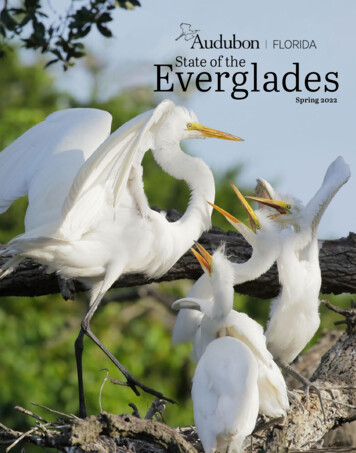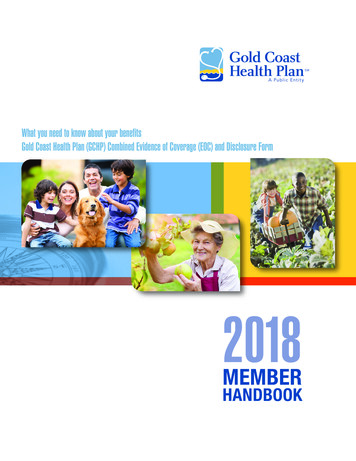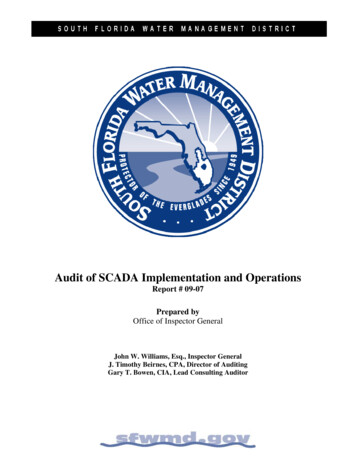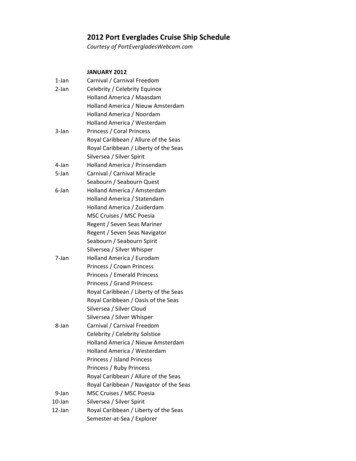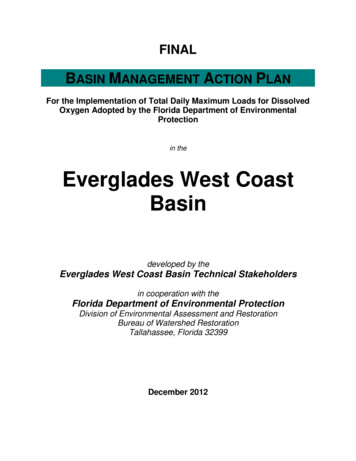
Transcription
FINALBASIN MANAGEMENT ACTION PLANFor the Implementation of Total Daily Maximum Loads for DissolvedOxygen Adopted by the Florida Department of EnvironmentalProtectionin theEverglades West CoastBasindeveloped by theEverglades West Coast Basin Technical Stakeholdersin cooperation with theFlorida Department of Environmental ProtectionDivision of Environmental Assessment and RestorationBureau of Watershed RestorationTallahassee, Florida 32399December 2012
FINAL Everglades West Coast Basin Management Action Plan – December 2012ACKNOWLEDGMENTS:The Everglades West Coast Basin Management Action Plan wasprepared as part of a statewide watershed management approach to restore and protectFlorida’s water quality. It was developed by the Everglades West Coast stakeholders, identifiedbelow, with participation from affected local, regional, and state governmental interests; electedofficials and citizens; and private interests.E VERGLADES WES T C OAS T B AS IN P ARTICIP ANTSENTITYFlorida Department of Environmental ProtectionSouth Florida Water Management DistrictFlorida Department of Agriculture andConsumer ServicesFlorida Department of Transportation –District 1City of Bonita SpringsLee CountyCatalina at Winkler PreserveCommunity Development Districtii
FINAL Everglades West Coast Basin Management Action Plan – December 2012For additional information on Total Maximum Daily Loads and the watershedmanagement approach in the Everglades West Coast Basin, contact:Beth Alvi, Basin CoordinatorFlorida Department of Environmental ProtectionBureau of Watershed Restoration, Watershed Planning and Coordination Section2600 Blair Stone Road, Mail Station 3565Tallahassee, FL 32399-2400Email: Elizabeth.Alvi@dep.state.fl.usPhone: (850) 245–8559iii
FINAL Everglades West Coast Basin Management Action Plan – December 2012TABLE OF CONTENTSLIS T OF ACRONYMS . XEXECUTIVE S UMMARY . 1CHAP TER 1 : CONTEXT, P URP OS E, AND S COP E OF THE P LAN . 51.1Water Quality Standards and Total Maximum Daily Loads . 51.2TMDL Implementation . 61.3The Everglades West Coast Basin Management Action Plan . 61.3.11.3.21.3.31.3.41.3.51.4Stakeholder Involvement . 6Plan Purpose and Scope . 8BMAP Approach .12Pollutant Reduction and Discharge Allocations .13Everglades West Coast Basin TMDLs .13Assumptions and Considerations Regarding TMDLImplementation . 141.4.11.4.2Assumptions.14Considerations .161.5Future Growth in the Watershed . 17CHAP TER 2 : HENDRY CREEK S ETTING . 192.1Land Use Coverage . 192.2Basin Hydrology . 192.3Water Quality Trends . 21CHAP TER 3 : HENDRY CREEK P OLLUTANT S OURCES AND ANTICIP ATEDOUTCOMES . 233.1Summary of Sources in the TMDLs . 233.1.13.1.2Stormwater Sources .23Agriculture .253.2Anticipated Outcomes of BMAP Implementation . 25CHAP TER 4 : HENDRY CREEK DETAILED ALLOCATIONS . 264.1Determining Detailed Allocations . 264.1.14.1.2Model Development .26Allocations .27CHAP TER 5 : HENDRY CREEK MANAGEMENT ACTIONS . 295.1Management Actions Types and Eligibility . 295.2MS4 Project Requirements . 295.3MS4 Projects to Reduce TN Loading . 305.4Credit Process . 315.4.15.5Public Education and Outreach .31Agriculture Allocations . 325.5.1Agricultural Producers’ Responsibilities under the FWRA.34iv
FINAL Everglades West Coast Basin Management Action Plan – December 20125.5.25.5.35.5.4Agricultural BMPs .34FDACS OAWP Role in BMP Implementation and Follow-Up.36FDEP and SFWMD Roles in BMP Implementation .37CHAP TER 6 : AS S ES S ING P ROGRES S AND MAKING CHANGES FORHENDRY CREEK . 416.1Tracking Implementation . 416.2Water Quality Monitoring . 446.2.16.2.26.2.36.2.46.2.5Water Quality Monitoring Objectives .44Water Quality Indicators and Resource Responses.44Monitoring Network .45Data Management and Assessment .48Quality Assurance/Quality Control .486.3Adaptive Management Measures . 48CHAP TER 7 : COMMITMENT TO P LAN IMP LEMENTATION FOR HENDRYCREEK . 50CHAP TER 8 : IMP ERIAL RIVER S ETTING . 528.1Land Use Coverage . 528.2Basin Hydrology . 528.3Water Quality Trends . 54CHAP TER 9 : IMP ERIAL RIVER P OLLUTANT S OURCES AND ANTICIP ATEDOUTCOMES . 559.1Summary of Sources in the TMDLs . 559.1.19.1.2Stormwater Sources .56Agriculture .579.2Anticipated Outcomes of BMAP Implementation . 57CHAP TER 10 : IMP ERIAL RIVER DETAILED ALLOCATIONS . 5910.1 Determining Detailed Allocations . 5910.1.1 Allocations .5910.1.2 Non-MS4 Urban Stormwater Allocations .60CHAP TER 11 : IMP ERIAL RIVER MANAGEMENT ACTIONS . 6111.1 Management Actions Type and Eligibility . 6111.2 MS4 Project Requirements . 6111.3 MS4 Projects to Reduce TN Loading . 6211.4 Credit Process . 6311.4.1 Conservation Land Purchase Credit .6411.4.2 Public Education and Outreach .6411.5 Agriculture Allocations . 6511.5.1 Addressing Agricultural Nonpoint Pollution .6811.5.2 Agricultural BMPs .6811.5.3 FDACS OAWP Role in BMP Implementation and Follow-Up.68v
FINAL Everglades West Coast Basin Management Action Plan – December 201211.5.4 FDEP and SFWMD Roles in BMP Implementation .69CHAP TER 12 : AS S ES S ING P ROGRES S AND MAKING CHANGES FOR THEIMP ERIAL RIVER . 7412.1 Tracking Implementation . 7412.2 Water Quality Monitoring . 7512.2.112.2.212.2.312.2.412.2.5Water Quality Monitoring Objectives .75Water Quality Indicators and Resource Responses.75Monitoring Network .76Data Management and Assessment .78Quality Assurance/Quality Control .7812.3 Adaptive Management Measures . 79CHAP TER 13 : COMMITMENT TO P LAN IMP LEMENTATION FOR THEIMP ERIAL RIVER . 80AP P ENDICES . 81Appendix A: TMDL Basin Rotation Schedule . 82Appendix B: Summary of Statutory Provisions Guiding BMAPDevelopment and Implementation . 83Appendix C: Stakeholder Involvement in BMAP Development . 86Appendix D: Summary of EPA-Recommended Elements of aComprehensive Watershed Plan . 87Appendix E: Glossary of Terms . 90Appendix F: Bibliography of Key References and Websites . 95Appendix G: BMAP Watershed Basin Development . 97vi
FINAL Everglades West Coast Basin Management Action Plan – December 2012LIST OF FIGURESFigure 1A: Hendry Creek WBIDs . 9Figure 1B: Hendry Creek Basin.10Figure 2A: Imperial River WBIDs .11Figure 2B: Imperial River Basin .12Figure 3: Land Uses in the Hendry Creek Watershed .20Figure 4: Agricultural Uses in the Hendry Creek Basin .33Figure 5: BMP Enrollment the Hendry Creek Basin as of December 31, 2011.39Figure 6: Monitoring Network for the Hendry Creek Basin .47Figure 7: Land Uses in the Imperial River Watershed .53Figure 8: Agricultural Uses in the Imperial River Basin .67Figure 9: BMP Enrollment in the Imperial River Basin as of December 31, 2011 .72Figure 10: Monitoring Network for the Imperial River Basin.77vii
FINAL Everglades West Coast Basin Management Action Plan – December 2012LIST OF TABLESTable 1: TMDLs in the Imperial River and Hendry Creek Basins . 2Table 2: Designated Use Attainment Categories for Florida Surface Waters . 5Table 3: Phases of the Watershed Management Cycle . 6Table 4: Everglades West Coast Basin Participants . 7Table 5: Everglades West Coast TMDLs .13Table 6: Approved TN Removal Efficiencies .15Table 7: 2004 Land Use Classifications in the Hendry Creek Watershed .19Table 8: Verified Parameters for Hendry Creek, WBIDs 3258B and 3258B1 .21Table 9: Summary of DO Monitoring Data in the Verified Period for Hendry Creek,WBIDs 3258B and 3258B1 .21Table 10: TN Required Reductions in the Hendry Creek Basin .23Table 11: Local Governments in the Hendry Creek Basin Designated as MS4Permittees .24Table 12: Land Use Categories and Loading Factors .27Table 13: TN Allocations for the Hendry Creek Basin MS4s .28Table 14: TN Required Reductions for the Hendry Creek Basin MS4s .28Table 15: Lee County Projects in Hendry Creek .30Table 16: FDOT Projects in Hendry Creek.31Table 17: Agricultural Land Uses in the Hendry Creek Basin (2004 SFWMD LandUse Data).32Table 18: Key Nutrient-Related BMPs Adopted by FDACS OAWP .35Table 19: Agricultural Acreage, BMP Enrollment, and Future Enrollment Goals forthe Hendry Creek Basin .38Table 20: Agricultural TN Load Reduction Allocation, and Estimated Reductions inTN Load In the First Five Years – Hendry Creek Basin.40Table 21: Proposed BMAP Annual Reporting Form .42Table 22: Water Quality Indicators and Field Parameters for the Hendry CreekBasin .45Table 23: Hendry Creek Basin BMAP Monitoring Network .46Table 24: 2004 Land Use Classifications in the Imperial River Watershed .52Table 25: Verified Parameters for the Imperial River .54Table 26: Summary of DO Monitoring Data in the Verified Period for the ImperialRiver .54Table 27: TN Required Reductions By Source in the Imperial River Basin .55Table 28: Local Governments in the Imperial River Basin Designated as MS4Permittees .56Table 29: Non-NPDES Wastewater Facilities Located in the Imperial RiverWatershed .57Table 30: TN Allocations for the Imperial River Basin MS4s .60Table 31: TN Required Reductions for the Imperial River Basin MS4s .60Table 32: Lee County Projects in the Imperial River Basin .62viii
FINAL Everglades West Coast Basin Management Action Plan – December 2012Table 33: Bonita Springs Projects in the Imperial River Basin .63Table 34: FDOT Projects in the Imperial River Basin .63Table 35: Agricultural Land Uses in the Imperial River Basin (2004 SFWMD LandUse Data).65Table 36: Agricultural Acreage, BMP Enrollment, and Future Enrollment Goals forthe Imperial River Basin .70Table 37: Agricultural TN Load Reduction Allocation and Estimated Reductions inTN Load in the First Five Years – Imperial River Basin .73Table 38: Water Quality Indicators and Field Parameters for the Imperial RiverBasin .76Table 39: Imperial River Basin BMAP Monitoring Network .78Table A-1: Major Hydrologic Basins by Group and FDEP District Office .82Table F-1: Stormwater and Water Quality Protection Websites.96ix
FINAL Everglades West Coast Basin Management Action Plan – December 2012LIS T OF MDLTKNTNTOCTSSTTUF-IFASUSGSWAFRWBIDAdvanced Wastewater TreatmentBasin Management Action PlanBest Management PracticeBiochemical Oxygen DemandCommunity Development DistrictCode of Federal RegulationsCharlotte Harbor National Estuary ProgramDischarge Monitoring ReportU.S. Environmental Protection AgencyEnvironmental Resource PermitFlorida Administrative CodeFlorida Administrative WeeklyFlorida Department of Agriculture and Consumer ServicesFlorida Department of Environmental ProtectionFlorida Department of HealthFlorida Department of TransportationFlorida Land Use and Cover Classification SystemFlorida StatutesFlorida Watershed Restoration ActFlorida Yards and NeighborhoodsImpaired Surface Waters RuleLoad AllocationLow Impact DevelopmentMaximum Extent PracticableMunicipal Separate Storm Sewer SystemNational Environmental Laboratory Accreditation ConferenceNotice of IntentNational Pollutant Discharge Elimination SystemNonpoint SourceOffice of Agricultural Water PolicyPermit Compliance SystemPublicly Owned Treatment WorksPublic Service AnnouncementQuality Assurance/Quality ControlSouth Florida Water Management DistrictStandard Operating ProcedureStormwater Management ProgramTotal Maximum Daily LoadTotal Kjeldahl NitrogenTotal NitrogenTotal Organic CarbonTotal Suspended SolidsTreatment TrainUniversity of Florida-Institute of Food and Agricultural SciencesU.S. Geological SurveyWastewater Facility RegulationWaterbody Identificationx
FINAL Everglades West Coast Basin Management Action Plan – December 2012WLAWWTFWWTPWasteload AllocationWastewater Treatment FacilityWastewater Treatment Plantxi
FINAL Everglades West Coast Basin Management Action Plan – December 2012E XECUTIVE S UMMARYEVERGLADES WEST COAST BASINHendry Creek and the Imperial River are both located in the Estero Bay Planning Unit within theEverglades West Coast Basin. Estero Bay proper is a shallow, subtropical lagoon with an areaof 17.7 square miles (mi2) (11,317 acres) and is separated from the Gulf of Mexico by barrierislands. Seagrass beds are common in the bay, but high turbidity restricts seagrass growth toshallow depths. The Estero and Imperial Rivers and Spring, Mullock, and Hendry Creeks arethe major tributaries that flow into Estero Bay.The Estero Bay region is generally characterized by slow, sheet-flow drainage patterns that aretypical of the flat, wetland-dominated, southern Florida landscape. In the past, the naturallydispersed water patterns distributed nutrients over broad areas of wetland vegetation. Seasonalfluctuations in flow from rainfall created the necessary salinity regime in Estero Bay for goodestuarine productivity. Increased development since the 1960s has led to changes in thenatural river systems around Estero Bay, altering freshwater inflow patterns (Florida Departmentof Environmental Protection [FDEP] 2003).Hendry Creek is located in the southwest part of Lee County in southwest Florida,approximately 3 miles south of the city of Ft. Myers and approximately 3 miles southeast of thecity of Cape Coral. For assessment purposes, Hendry Creek is divided into a predominantlyfreshwater segment and a predominantly marine segment. U.S. Route 41 runs between the twosegments. Hendry Creek flows south for approximately 6 miles into north Estero Bay anddrains a watershed of about 15.35 mi2. Most development is in the north end of the watershed,and wetlands and water dominate the southern portion.The Imperial River watershed covers approximately 23.1 mi2 (14,784 acres), of which 6.9 mi2(4,416 acres) are surface waters. Oak Creek and Leitner Creek flow into the upstream portionof the Imperial River. Both of these drainage areas, as well as the adjacent watershed, containextensive areas of cropland and pastureland. As the Imperial River runs adjacent to the city ofBonita Springs, it receives extensive amounts of urban runoff along the majority of its length(FDEP 2003).As part of the Basin Management Action (BMAP) process, FDEP worked with the stakeholdersto refine the basin boundaries for both the Imperial River and Hendry Creek basins to betterrepresent actual conditions. These refined basin areas were then used for the purposes ofassigning and allocating pollutant loads to the stakeholders.TOTAL MAXIMUM DAILY LOADSTotal Maximum Daily Loads (TMDLs) are water quality targets, based on state water qualitystandards, for specific pollutants (such as nitrogen and phosphorus). FDEP identified theImperial River and Hendry Creek to be impaired for low dissolved oxygen (DO) and, in August2008, adopted TMDLs that target reductions in total nitrogen (TN) in the river and creeksegments to address the low DO condition. The table below lists the TMDLs adopted by rule foreach of the impaired segments with a waterbody identification (WBID) number in the ImperialRiver and Hendry Creek Basins.1
FINAL Everglades West Coast Basin Management Action Plan – December 2012TABLE 1: TMDLS IN THE IMP ERIAL R IVER AND HENDRY C REEK B AS INSWLA FORWAS TEWATER(LBS /YEAR )WLA FOR NP DESS TORMWATER(% R EDUCTION)LA(% R EDUCTION)WBIDWATERBODYP ARAMETERTMDL(MG /L)3258BHendry CreekTN0.74Not applicable44%44%3258B1Hendry CreekTN0.60Not applicable44%44%3258EImperial RiverTN0.74Not applicable24.87%24.87%FDEP used the Impaired Surface Waters Rule (IWR) to assess water quality impairments forthe freshwater portion of the Imperial River and both the freshwater and marine segments ofHendry Creek and has verified the impairments for low DO. The Imperial River was verified asimpaired for DO based on data indicating that the exceedance rate is greater than or equal to10%. The DO impairment in the two waterbody segments (freshwater and marine) of HendryCreek was verified based on the observation that DO values for 31 out of 59 samples in thefreshwater segment and 34 out of 39 samples in the marine segment collected during theverified period (January 1, 2000, through June 30, 2007) were lower than the state water qualitycriteria for Class III freshwater and marine systems, respectively. TN was considered thecausative pollutant for impairment in both the Imperial River and Hendry Creek. The TMDLs forthe Imperial River and Hendry Creek established the allowable loading of TN to that wouldrestore them so that they meet their applicable water quality criteria for DO.It should be noted that during the development of the BMAP document, the WBID boundariesfor Hendry Creek and Imperial River were modified to better reflect the marine and freshwaterinterface. In particular, WBID 3258B and 3258B1 have been combined into a single marineWBID 3258B2 for Hendry Creek based on hydrology, Lee County watershed coverage, andFDEP District feedback. Also, WBID 3258E has been combined with 3258C to become3258EA. These WBID changes will be addressed in the re-listing process for Cycle 3.Nevertheless, this BMAP considers the TMDL for the older WBID boundaries and will bemodified in the future accordingly.THE EVERGLADES WEST COAST BASIN MANAGEMENT ACTION PLANThe purpose of this BMAP is to implement TN reductions for the Hendry Creek and ImperialRiver Basins to achieve the TMDLs for DO. The BMAP provides for phased implementationunder Paragraph 403.067(7)(a)1, Florida Statutes (F.S.). The management actions andadaptive management approach described in the BMAP will address TN reductions, and theprocess will continue until the TMDLs are attained or the DO water quality standard is met. Thephased BMAP approach allows for the implementation of projects designed to achieveincremental reductions, while simultaneously monitoring and conducting studies to betterunderstand the water quality dynamics (sources and response variables) in the watershed. Thetotal required reductions to meet the TMDLs are spread out over a maximum 15-year timeframe.During the course of BMAP development, stakeholders reiterated concerns identified during theTMDL adoption process with regards to portions of the TMDL, including a concern that the lowDO may be a naturally occurring condition. The TMDLs are scheduled to be refined over thenext few years. While the TMDL modeling is refined, FDEP requested that the stakeholdersprovide activities and projects that would reduce the TN load to some degree. Accordingly, tothe extent that the projects and other activities listed in 5.3 and 11.3 (or comparable projectsand other activities approved by FDEP) are implemented on a timely basis, those applicable2
FINAL Everglades West Coast Basin Management Action Plan – December 2012entities shall be presumed to be in compliance with this BMAP. After the first 5 years of BMAPimplementation, stakeholders will evaluate progress and make adjustments as needed to meetfuture refined TMDLs. Additionally, FDEP is currently proposing changes to the DO standarddefined in Rule 62-302.520(30), Florida Administrative Code (F.A.C.). If the DO standardchanges, then FDEP will review the impairment status of both Hendry Creek and the ImperialRiver.KEY ELEMENTS OF THE BMAPThis BMAP addresses the key elements required by the Florida Watershed Restoration Act(FWRA), Chapter 403.067, F.S., including the following: Document how the public and other stakeholders were encouraged toparticipate or participated in developing the BMAP (Section 1.3.1 andAppendix C); Equitably allocate pollutant reductions in the basin (Sections 4 and 10); Identify the mechanisms by which potential future increases in pollutantloading will be addressed (Section 1.5); Document management actions/projects to achieve the TMDLs (Sections 4and 10); Document the implementation schedule, funding, responsibilities, andmilestones (section); and Identify monitoring, evaluation, and a reporting strategy to evaluatereasonable progress over time (Sections 5 and 11).ANTICIPATED OUTCOMES OF BMAP IMPLEMENTATIONThrough the implementation of projects, activities, and additional source assessment in thisBMAP, stakeholders expect the following outcomes: Improved water quality trends in Hendry Creek and the Imperial River; Decreased loading of the target pollutant (TN); Increased coordination between state and local governments and withindivisions of local governments in problem solving for surface water qualityrestoration; Determination of effective projects through the stakeholder decision-makingand priority-setting processes; Enhanced public awareness of pollutant sources, pollutant impacts on waterquality, and corresponding corrective actions; and Enhanced understanding of basin hydrology, water quality, and pollutantsources.BMAP COST AND TIME FRAMECosts totaling 4.925 million were provided for 22% of the activities identified in the BMAP. It isimportant to note that since the TMDL is scheduled to be refined over the next few years,stakeholders were asked to provide activities and projects t
FINAL Everglades West Coast Basin Management Action Plan - December 2012 ii ACKNOWLEDGMENTS: The Everglades West CoastBasin Management Action Plan was prepared as part of a statewide watershed management approach to restore and protect Florida's water quality. It was developed by the Everglades West Coast stakeholders, identified


